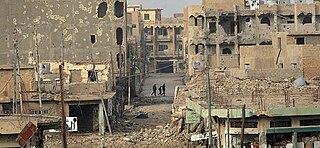Related Research Articles

In statistics, cluster sampling is a sampling plan used when mutually homogeneous yet internally heterogeneous groupings are evident in a statistical population. It is often used in marketing research.

Mortality rate, or death rate, is a measure of the number of deaths in a particular population, scaled to the size of that population, per unit of time. Mortality rate is typically expressed in units of deaths per 1,000 individuals per year; thus, a mortality rate of 9.5 in a population of 1,000 would mean 9.5 deaths per year in that entire population, or 0.95% out of the total. It is distinct from "morbidity", which is either the prevalence or incidence of a disease, and also from the incidence rate.

The International Rescue Committee (IRC) is a global humanitarian aid, relief, and development nongovernmental organization. Founded in 1933 as the International Relief Association, at the request of Albert Einstein, and changing its name in 1942 after amalgamating with the similar Emergency Rescue Committee, the IRC provides emergency aid and long-term assistance to refugees and those displaced by war, persecution, or natural disaster. The IRC is currently working in about 40 countries and 26 U.S. cities where it resettles refugees and helps them become self-sufficient. It focuses mainly on health, education, economic wellbeing, power, and safety.

Iraq Body Count project (IBC) is a web-based effort to record civilian deaths resulting from the US-led 2003 invasion of Iraq. Included are deaths attributable to coalition and insurgent military action, sectarian violence and criminal violence, which refers to excess civilian deaths caused by criminal action resulting from the breakdown in law and order which followed the coalition invasion. As of February 2019, the IBC has recorded 183,249 – 205,785 civilian deaths. The IBC has a media-centered approach to counting and documenting the deaths. Other sources have provided differing estimates of deaths, some much higher. See Casualties of the Iraq War.

Estimates of the casualties from the Iraq War have come in several forms, and those estimates of different types of Iraq War casualties vary greatly.

Richard Charles Horton is editor-in-chief of The Lancet, a United Kingdom–based medical journal. He is an honorary professor at the London School of Hygiene and Tropical Medicine, University College London, and the University of Oslo.

The Lancet, one of the oldest scientific medical journals in the world, published two peer-reviewed studies on the effect of the 2003 invasion of Iraq and subsequent occupation on the Iraqi mortality rate. The first was published in 2004; the second in 2006. The studies estimate the number of excess deaths caused by the occupation, both direct and indirect.
On 6 August 1990, four days after the Iraqi invasion of Kuwait, the United Nations Security Council (UNSC) placed a comprehensive embargo on Iraq. The sanctions stayed largely in force until 22 May 2003, and persisted in part, including reparations to Kuwait. The original stated purposes of the sanctions were to compel Iraq to withdraw from Kuwait, to pay reparations, and to disclose and eliminate any weapons of mass destruction (WMD).

The Iraqi civil war was an armed conflict from 2006 to 2008 between various sectarian Shia and Sunni armed groups, such as the Islamic State of Iraq and the Mahdi Army, in addition to the Iraqi government alongside American-led coalition forces. In February 2006, the insurgency against the coalition and government escalated into a sectarian civil war after the bombing of Al-Askari Shrine, considered a holy site in Twelver Shi'ism. US President George W. Bush and Iraqi officials accused Al-Qaeda in Iraq (AQI) of orchestrating the bombing. AQI publicly denied any links. The incident set off a wave of attacks on Sunni civilians by Shia militants, followed by attacks on Shia civilians by Sunni militants.

The Iraq War was a protracted armed conflict in Iraq from 2003 to 2011. It began with the invasion of Iraq by the United States-led coalition that overthrew the Ba'athist government of Saddam Hussein. The conflict continued for much of the next decade as an insurgency emerged to oppose the coalition forces and the post-invasion Iraqi government. US troops were officially withdrawn in 2011.

The emerging field of conflict epidemiology offers a more accurate method to measure deaths caused during violent conflicts or wars that can generate more reliable numbers than before to guide decision-makers.
On Friday, 14 September 2007, ORB International, an independent polling agency located in London, published estimates of the total war casualties in Iraq since the US-led invasion of Iraq in 2003. At over 1.2 million deaths (1,220,580), this estimate is the highest number published so far. From the poll margin of error of +/-2.5% ORB calculated a range of 733,158 to 1,446,063 deaths. The ORB estimate was performed by a random survey of 1,720 adults aged 18+, out of which 1,499 responded, in fifteen of the eighteen governorates within Iraq, between August 12 and August 19, 2007. In comparison, the 2006 Lancet survey suggested almost half this number through the end of June 2006. The Lancet authors calculated a range of 392,979 to 942,636 deaths.
On January 9, 2008 the World Health Organization reported the results of the "Iraq Family Health Survey" published in the New England Journal of Medicine. The study surveyed 9,345 households across Iraq and was carried out in 2006 and 2007. It estimated 151,000 deaths due to violence from March 2003 through June 2006.
The Iraq War resulted in multiple humanitarian crises.

The Iraq War started with a US-led invasion on 20 March 2003, causing much damage to the capital city, Baghdad. The war and collateral damage continued for years.
The Iraq War documents leak is the disclosure to WikiLeaks of 391,832 United States Army field reports, also called the Iraq War Logs, of the Iraq War from 2004 to 2009 and published on the Internet on 22 October 2010. The files record 66,081 civilian deaths out of 109,000 recorded deaths. The leak resulted in the Iraq Body Count (IBC) project adding 15,000 civilian deaths to their count, bringing their total to over 150,000, with roughly 80% of those civilians. It is the biggest leak in the military history of the United States, surpassing the Afghan War documents leak of 25 July 2010.
The Sisterhood Method is a household survey to estimate maternal deaths recommended by the World Health Organization (WHO). Although maternal deaths are a major problem in developing countries, high quality data are rare. Yet, numbers are needed for planning in order to reduce the problem of maternal death. Several methods have been used to estimate maternal deaths. According to the WHO, "The approach was designed to overcome the problem of large sample sizes and thus reduce cost."
The Million Death Study (MDS) is an ongoing human premature mortality study conducted in India. It began in 1998 and ended in 2014. Among a sample size of 14 million Indians, approximately 1 million deaths are assigned as medical causes through the Verbal Autopsy method to determine disease patterns and direct public health policy. The principal investigator of the study is Dr. Prabhat Jha, director of the Centre for Global Health Research and professor of epidemiology at the Dalla Lana School of Public Health, University of Toronto, Canada.

Childbirth in Iraq is marked by a fertility rate of 4.0 births per woman, a contested but high maternal mortality rate and a moderately high infant mortality rate.

Casualty recording is the systematic and continuous process of documenting individual direct deaths from armed conflict or widespread violence. It aims to create a comprehensive account of all deaths within a determined scope, usually bound by time and location.
References
- ↑ "Critics say 600,000 Iraqi dead doesn't tally. Pollsters defend methods used in Johns Hopkins study". By Anna Badkhen. San Francisco Chronicle. Oct. 12, 2006.
- 1 2 Faculty page for Les Roberts Archived 2008-04-16 at the Wayback Machine . Columbia University's Mailman School of Public Health.
- ↑ CNN Archived May 8, 2006, at the Wayback Machine
- ↑ ""Mortality before and after the 2003 invasion of Iraq: cluster sample survey"" (PDF). Archived from the original (PDF) on 2005-12-01. (263 KB). By Les Roberts, Riyadh Lafta, Richard Garfield, Jamal Khudhairi, and Gilbert Burnham. The Lancet , 29 October 2004. There is a version of the PDF article that has a clickable table of contents. It is here: "Archived copy" (PDF). Archived from the original (PDF) on 2012-03-09. Retrieved 2012-02-14.
{{cite web}}: CS1 maint: archived copy as title (link). - ↑ Straw, Jack. "Iraq (Casualty Estimates)". Parliament. Retrieved 4 April 2012.
- ↑ ""Mortality after the 2003 invasion of Iraq: a cross-sectional cluster sample survey"" (PDF). Archived from the original (PDF) on 2015-09-07. (242 KB). By Gilbert Burnham, Riyadh Lafta, Shannon Doocy, and Les Roberts. The Lancet, October 11, 2006
- ↑ Iraqi deaths survey 'was robust'. BBC News, 26 March 2007.
- ↑ "Invaders dispute Iraqi death toll". The Australian. Retrieved 4 April 2012.
- ↑ "Iraqi official estimates at least 150,000 Iraqis killed by insurgents" Archived 2006-12-17 at the Wayback Machine . Nov. 9, 2006. Associated Press.
- ↑ "Reality checks: some responses to the latest Lancet estimates". By Hamit Dardagan, John Sloboda, and Josh Dougherty. Iraq Body Count project. October 16, 2006.
- ↑ "Press Release 14 (16 Oct 2006)". Iraq Body Count. 2006-10-16. Retrieved 2010-08-10.
- ↑ "Exaggerated claims, substandard research, and a disservice to truth :: Iraq Body Count".
- ↑ "1" (PDF). Archived from the original (PDF) on 2010-06-13. Retrieved 2010-08-10.
- ↑ "International Committee of the Red Cross" (PDF). 3 October 2013.
- ↑ "Socrates and Berkeley Scholars Web Hosting Services Have Been Retired | Web Platform Services" (PDF).